Eating scorpions are not part of mainstream culture in many countries, but food and water are essential for survival when thrown into a survival situation. Therefore, even the pickiest eaters must be creative.
Scorpions are packed with protein, abundant in certain areas, and relatively easy to find and catch; scorpions may save your life.
Eating these creatures may not appeal to the squeamish, but they are delicious when prepared correctly. However, safely catching and preparing these venomous animals requires knowledge and skill.
Table of contents
Can You Eat Scorpions?
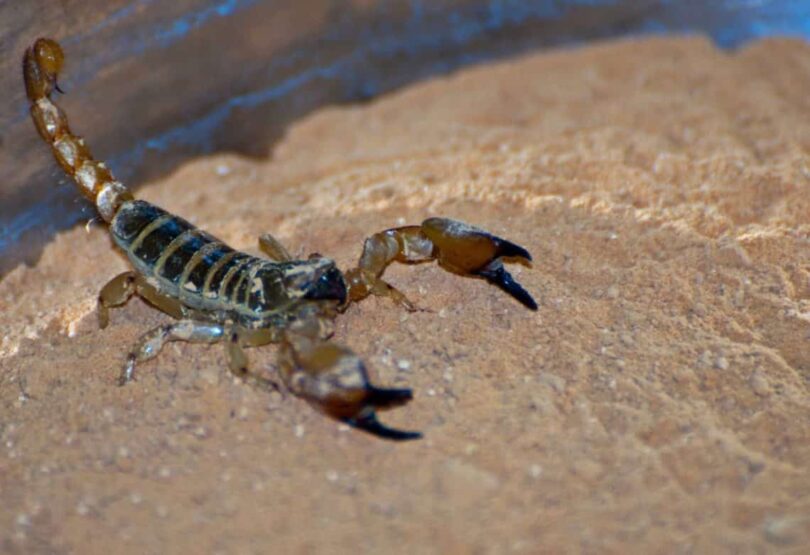
With their famous stingers, scorpions are typically avoided by most adventurers, but in a survival situation, you may not have that luxury.
Scorpions can be eaten and even enjoyed if prepared correctly.
See also: Edible Insects: Rich Protein-Packed Grub
Benefits of Eating Scorpions
In addition to tasting good, there are other things to consider.
- Protein – Scorpions – and other bugs – are packed full of protein. Scorpions can be comprised of 80% protein!
- Calories – This is important in a survival situation. The more calories you can eat, the better.
- Population – In certain areas, scorpion populations are very high, creating a reasonably reliable food source.
- Capture – With a few tips and tricks up your sleeve, it’s not difficult to catch a large number of scorpions without getting stung.
- Taste – The taste, when cooked, has been likened to the crispy chicken skin, popcorn shrimp, and even crab. When raw, it doesn’t taste like much at all.
Although it can be perfectly safe to eat scorpions, and health benefits may even encourage you to eat them outside of survival, there is a bit more to eating scorpions than simply knowing that you can.
Catching and preparing scorpions takes some skill and experience, and understanding the types of scorpions is essential.
About Scorpions
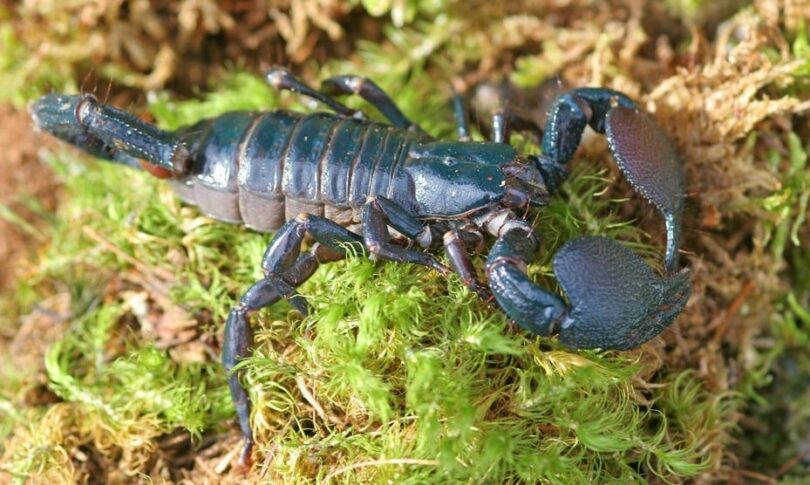
There are over 1,500 different species of scorpions, and only about 40 are deadly to humans. The power of the sting or venom differs, with some feeling similar to a bee sting, while others are closer to a bullet ant bite.
An allergic reaction from an otherwise non-deadly sting can result in death, so it is always essential you are careful when handling scorpions.
Typical Habitat
Scorpions generally prefer warm, dry climates and are most common in semi-arid regions.
However, this is an adaptable creature, and scorpions can be found in forests, jungles, savannahs, caves, and even mountains.
Activity
Scorpions are generally nocturnal creatures and spend most of the day hidden away under rocks, logs, and in other nooks and crannies. Some species even burrow into the earth.
During the night, they actively hunt and roam, looking for prey.
Scorpions are one of the main reasons I don’t “cowboy camp” in the desert. Also, always check my shoes the following day if I leave them outside my shelter.
Diet
Scorpions typically ambush their prey. T ey feast on insects, spiders, and smaller scorpions, occasionally using their venom to paralyze them. They use their venom to break down their food before sucking up the remains.
Scorpions in the US
There are about 90 scorpion species found in the US, mainly in the southwestern states. A zona, California, and New Mexico have the highest scorpion populations, but they can also be found in many neighboring states.
The three most common scorpions in the States include the following;
Bark Scorpion
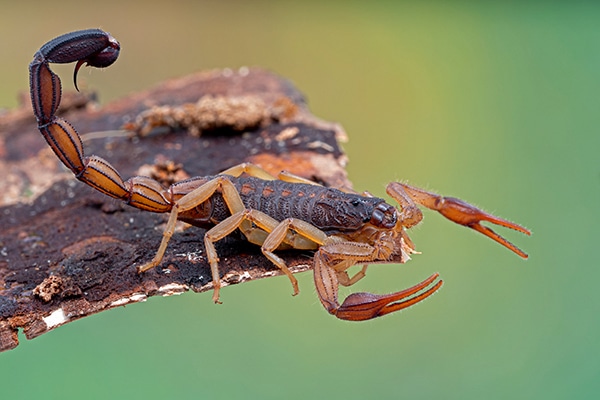
This is the most venomous scorpion. Th sting is excruciating and can lead to numbness and vomiting for up to 72 hours. Ce tain areas of the body can become immobilized if stung, such as the hand or foot.
Though rare, the sting can be deadly to humans, particularly the elderly, children, and those with poor immune systems.
Bark scorpions are light brown and grow up to 4″ in length, with a slender tail and legs. Th y enjoy semi-arid conditions and can be found under rocks, logs, or behind tree bark during the day.
Giant Hairy Desert Scorpion
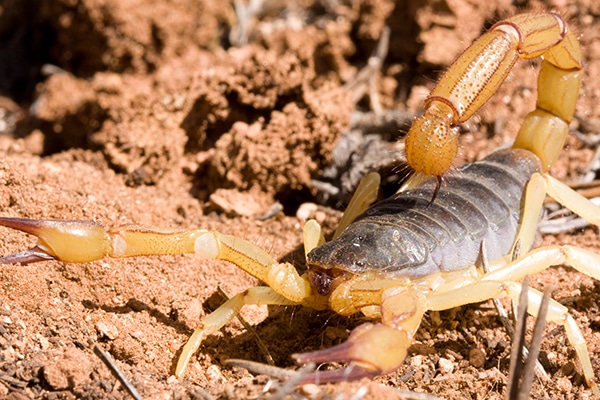
This is the largest scorpion in the US and the stuff of which movies are made!. Its sting is thankfully not very potent and is often compared to a bee sting.
Allergies to giant hairy desert scorpions are more common, and these reactions can be fatal.
These scorpions are typically found in the Sonora and Mojave deserts, in low altitude valleys. They burrow but can also often be found under rocks during the day. They’re yellow, with a darker back, and can grow as big as 7″ long.
Stripe Tailed Scorpion
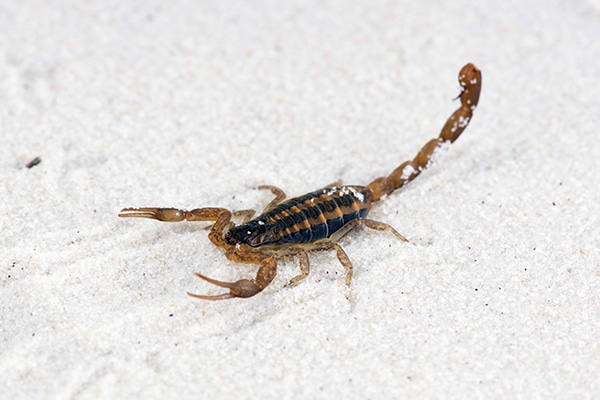
The telltale stripes and thick tail distinguish this creature from a bark scorpion. It s similarly yellowish-brown in color but has dark lines running vertically along its back and tail.
The Stripe Tailed Scorpions venom is not particularly dangerous to humans, though it can be painful.
This scorpion enjoys a humid climate and dwells under rocks on sandy soil. Th y typically grow to around 2½” in length.
How to Catch Scorpions
There are a few tips to follow when hunting scorpions.
Shine a Light
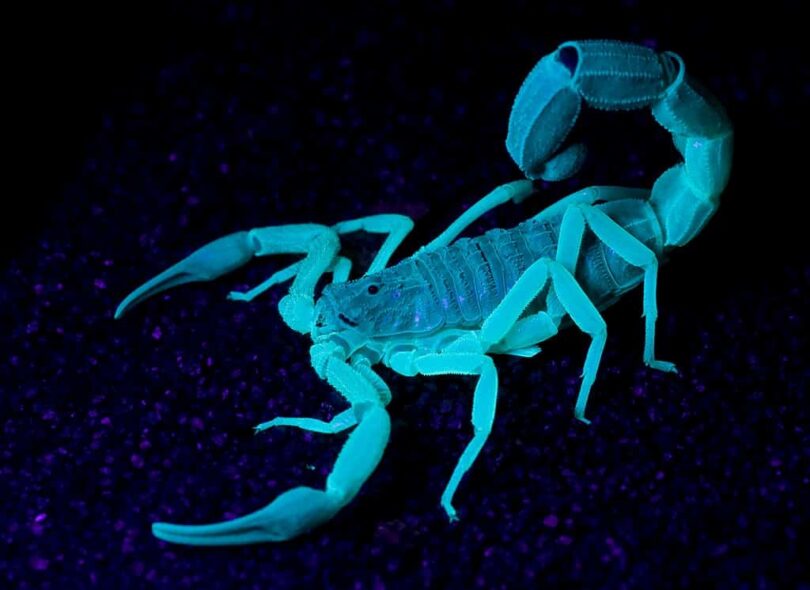
One thing that the vast majority of scorpions have in common is that they glow under UV light. The reason for this is largely unknown, though there are several theories.
This is undoubtedly an advantage when hunting scorpions at night.
Set Traps
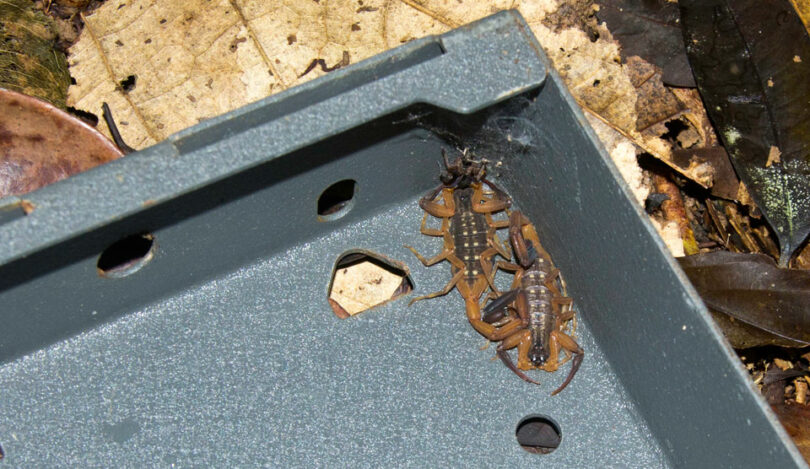
Traps are handy when hunting a burrowing scorpion. First, you’ll need to look for signs that give their hiding places away. If it is light, get close to the ground and look for small holes beneath low-hanging rocks, tree roots, crevices, or logs.
This is typically a scorpion’s den. In front of the cave, dig another hole, big enough to fit a cup or other wide-mouthed container in. At night, the scorpion will leave its burrow and fall into the trap.
The smooth, vertical sides of the container will prevent the scorpion from escaping until you retrieve it.
Leave No Stone Unturned
In the desert, rocks often shelter sleeping scorpions during the day. Tu n over as many stones as you can, and you’re bound to find a few scorpions sheltering beneath.
Logs, in particular rotten pine, are another favorite. Tu n these over to find the nocturnal creatures sleeping also.
Dig for Your Dinner
In certain Asian countries, it is common practice to locate scorpion burrows and dig out the scorpions. You can find enough scorpions in the right areas to make these efforts worthwhile.
Preparing a Scorpion to Eat
Now that you’ve caught your scorpions, you need to know how to prepare them. Scorpions are fast and dangerous, so you shouldn’t just grab them with your bare hands.
Handling Live Scorpions
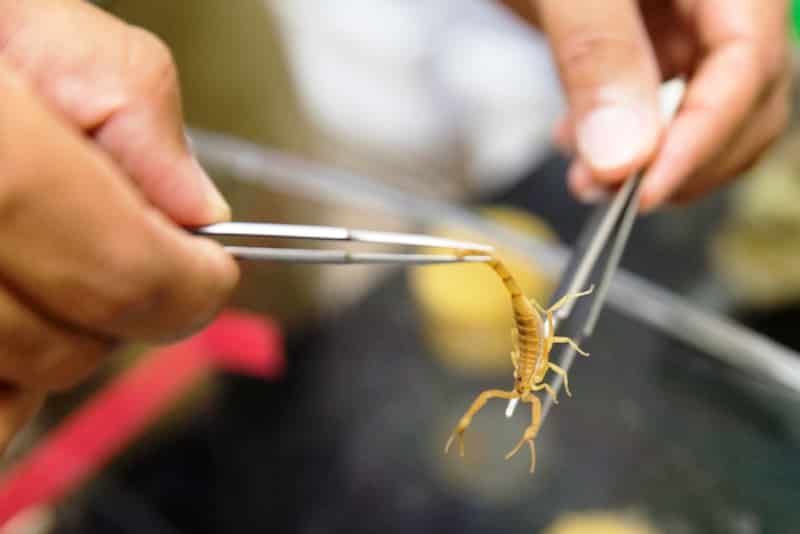
Scorpions can move quickly enough to sting those hunting them. The sting can pack a punch and should be avoided at all costs. If possible, wear gloves when handling scorpions.
If gloves are not possible, use a long pair of tongs. Some of these are items you’re unlikely to have access to in a survival situation. Use a sturdy, thin stick to hold the scorpion down by the trail. Alw ys keep the scorpion away from you.
Killing a Scorpion
The quickest way to kill a scorpion is to pierce the hard outer shell and crush its head. A sharp object is the best tool to do this with, though a blunt object can also be used.
If possible, pin the tail and stinger down with a stick before killing the scorpion.
Preparing a Scorpion to Eat
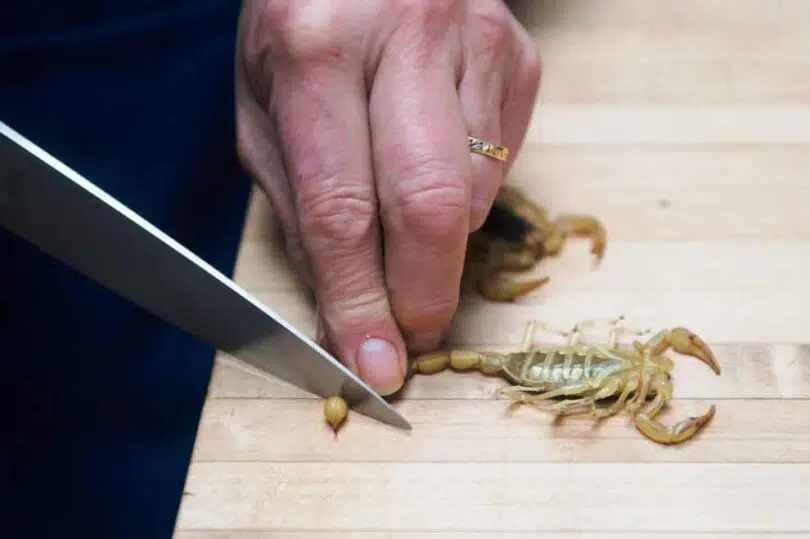
It is important to note that even when a scorpion is dead, iit’sstill dangerous until the stinger and venom gland has been removed.
The stinger is located at the tip of the tail, and the venom gland is directly below it. This is a bulbous section at the tail end in some scorpions, but it is not so apparent with other species.
You may notice some of the slightly opaque venom leaking out after you’ve cut the stinger and gland off. Once that is done, the rest of the scorpion can be consumed.
IIt’sbetter to cook them, partly to improve the taste and ensure they are clean. It” likely that a scorpion will carry parasites, but not impossible.
If there is no alternative, however, they can be eaten raw. The entire scorpion is edible once the stinger and venom gland has been removed. Just pop it in your mouth and chew.
Cooking a Scorpion
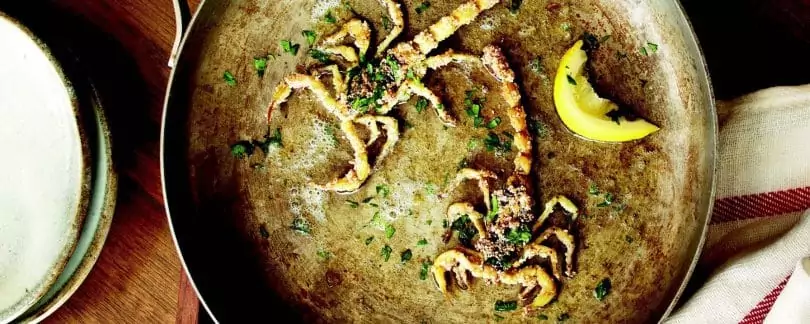
It is not uncommon to leave the stinger and venom gland on if yoyou’relanning to cook the scorpion. It is believed that eating a scorpion with a stinger on it will make you strong and virile.
The risk is that you may be allergic to some of the properties of venom. In a survival situation, an allergic reaction is something you will want to avoid at all costs. It’s best to err on the side of caution.
The easiest way to cook a scorpion is to skewer it and roast it over a fire or hot coals. It is similar to roasting marshmallows. Ensure that you hold the scorpion back from the flames to avoid burning it, and turn it from time to time to ensure it’s thoroughly cooked.
Once the outside becomes a nice brown color, it’s ready to eat. Eat the whole thing, and don’t worry about the shell. All of it is now edible. The best meat is in the tail and claws, like lobster or crab. It s ould be somewhat crispy and crunchy.
Scorpions in the Kitchen
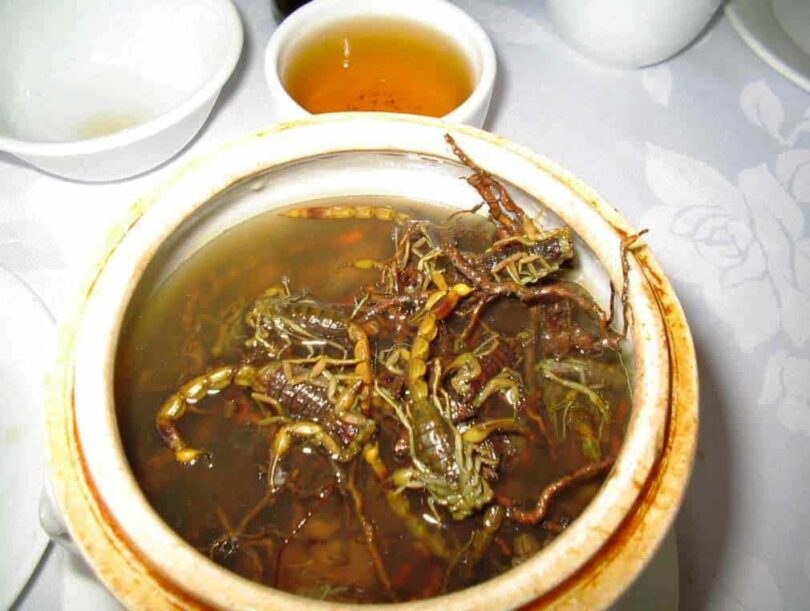
There is no reason why scorpions cannot become part of your regular diet outside of a survival situation. They taste great, ththey’rebundant, and many recipes use scorpions as an ingredient.
Suppose you’re catching scorpions to eat at a later date. It’s best to freeze them for storage. The venom gland should be removed before thawing unless you’re confident that it will not harm you.
There are many ways to cook scorpions.
Scorpion soup is a popular dish, and scorpion scaloppini are quick, easy, and delicious. More often than not, scorpions are flash-fried. Use searing hot oil, and a couple of minutes or so in a pan – depending on the size – is all they need.
Once cooked, season with salt and pepper or a spice mix of your choice and enjoy.
Final Thoughts

Scorpions are an abundant and good food source for survival situations and daily consumption. However, never forget that these creatures can be deadly.
If you are not familiar with an area, use caution when collecting them, no matter how desperate the situation.
Remember, if you cannot cook your scorpions before you eat them, you must remove the stinger and venom gland. To be on the safe side, it’s the practice to do this even if you are cooking them. But w y wait until youyou’reught in a desperate situation?
Consider taking a trip into the desert to start hunting scorpions. This will give you a good idea of what to look for and how best to handle scorpions. Also, when our life depends on eating scorpions, it will be good to understand how to manage them.
Cooking Resources
I understand that cooking bugs and insects may not be exciting, but you would be surprised at
I’vI’vested a few resources below for those that are curious and adventurous!
| Name | Price | |
|---|---|---|
 | The Eat-a-Bug Cookbook | Shop Here |
 | The Art of Eating through the Zombie Apocalypse | Shop Here |
 | EDIBLE INSECT COOKBOOK: Try 75+ delicious recipes... | Shop Here |
 | Eat Grub: The Ultimate Insect Cookbook | Shop Here |
When you purchase through links on this website, I receive a small commission at no additional cost to you. If you find this content interesting or helpful and decide to purchase, please consider purchasing through the links above. Thank you






Nice blog thanks for sharing.